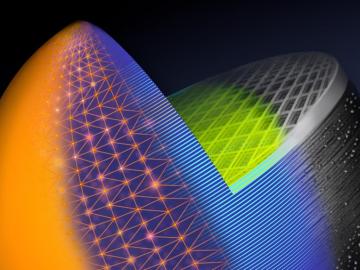
Filter News
Area of Research
News Type
News Topics
- (-) 3-D Printing/Advanced Manufacturing (16)
- (-) Bioenergy (8)
- (-) Biomedical (8)
- (-) Clean Water (2)
- (-) Machine Learning (7)
- (-) Materials Science (19)
- (-) Quantum Science (15)
- Advanced Reactors (3)
- Artificial Intelligence (30)
- Big Data (11)
- Biology (12)
- Biotechnology (6)
- Buildings (15)
- Chemical Sciences (17)
- Climate Change (13)
- Composites (7)
- Computer Science (26)
- Critical Materials (6)
- Decarbonization (18)
- Education (2)
- Emergency (1)
- Energy Storage (8)
- Environment (16)
- Exascale Computing (12)
- Fossil Energy (2)
- Frontier (10)
- Fusion (9)
- Grid (9)
- High-Performance Computing (21)
- Isotopes (14)
- Materials (16)
- Mathematics (3)
- Microelectronics (2)
- Microscopy (2)
- Molten Salt (1)
- Nanotechnology (1)
- National Security (23)
- Net Zero (4)
- Neutron Science (15)
- Nuclear Energy (10)
- Partnerships (19)
- Physics (7)
- Polymers (2)
- Quantum Computing (13)
- Security (4)
- Simulation (14)
- Space Exploration (3)
- Statistics (2)
- Summit (8)
- Sustainable Energy (15)
- Transportation (6)
Media Contacts

To better predict long-term flooding risk, scientists at the Department of Energy’s Oak Ridge National Laboratory developed a 3D modeling framework that captures the complex dynamics of water as it flows across the landscape. The framework seeks to provide valuable insights into which communities are most vulnerable as the climate changes, and was developed for a project that’s assessing climate risk and mitigation pathways for an urban area along the Southeast Texas coast.

Participants in the SM2ART Research Experience for Undergraduates program got the chance to see what life is like in a research setting. REU participant Brianna Greer studied banana fibers as a reinforcing material in making lightweight parts for cars and bicycles.

Advanced materials research to enable energy-efficient, cost-competitive and environmentally friendly technologies for the United States and Japan is the goal of a memorandum of understanding, or MOU, between the Department of Energy’s Oak Ridge National Laboratory and Japan’s National Institute of Materials Science.

Researchers at ORNL have developed the first additive manufacturing slicing computer application to simultaneously speed and simplify digital conversion of accurate, large-format three-dimensional parts in a factory production setting.

Researchers used quantum simulations to obtain new insights into the nature of neutrinos — the mysterious subatomic particles that abound throughout the universe — and their role in the deaths of massive stars.

In May, the Department of Energy’s Oak Ridge and Brookhaven national laboratories co-hosted the 15th annual International Particle Accelerator Conference, or IPAC, at the Music City Center in Nashville, Tennessee.
Close on the heels of its fourth summer school, the Quantum Science Center, or QSC, hosted its second in-person all-hands meeting in early May. More than 150 scientists, engineers and support staff traveled from 17 institutions to review the QSC’s progress, examine existing priorities and brainstorm new short- and long-term research endeavors.

Researchers at ORNL and the University of Maine have designed and 3D-printed a single-piece, recyclable natural-material floor panel tested to be strong enough to replace construction materials like steel.

When Oak Ridge National Laboratory's science mission takes staff off-campus, the lab’s safety principles follow. That’s true even in the high mountain passes of Washington and Oregon, where ORNL scientists are tracking a tree species — and where wildfires have become more frequent and widespread.

Purdue University hosted more than 100 attendees at the fourth annual Quantum Science Center summer school. Students and early-career members of the QSC —headquartered at ORNL — participated in lectures, hands-on workshops, poster sessions and panel discussions alongside colleagues from other DOE National Quantum Information Science Research Centers.


